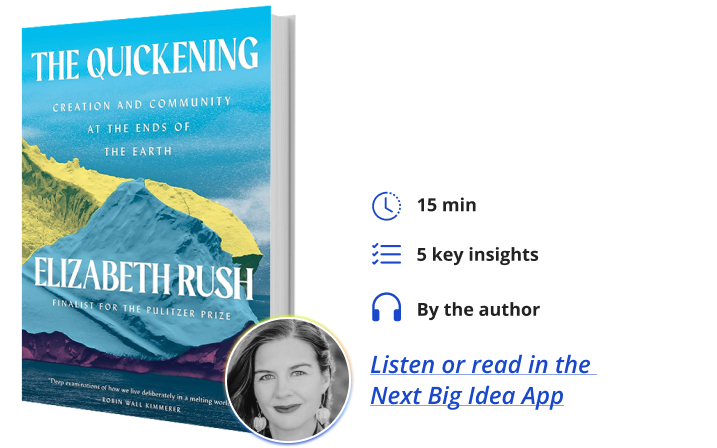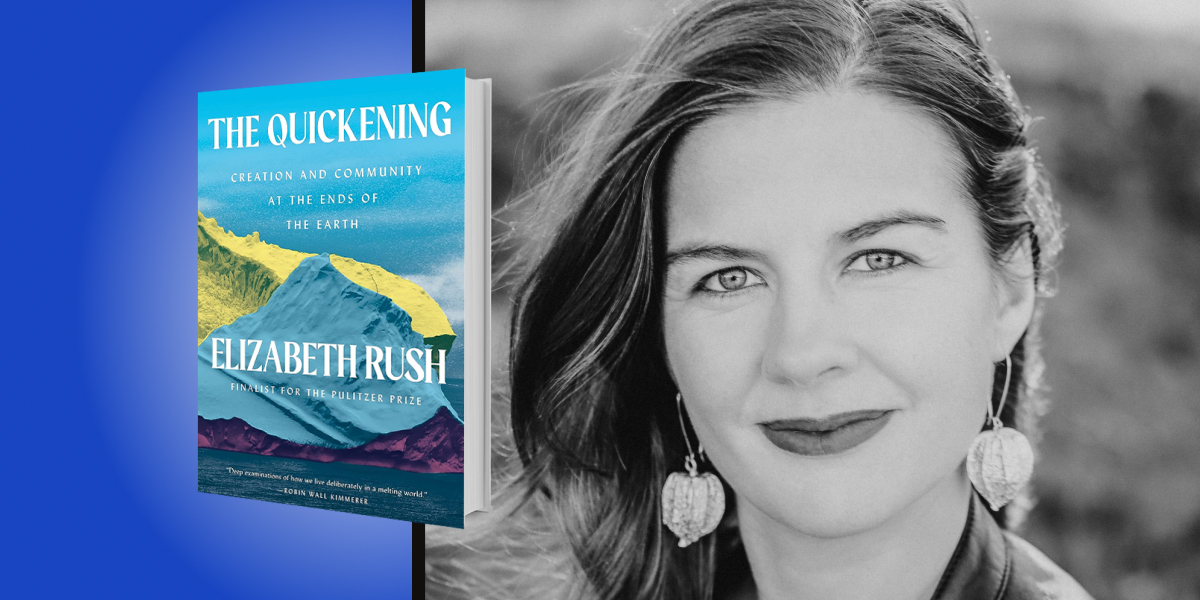Elizabeth Rush is an author whose latest title, Rising: Dispatches from the New American Shore, was a finalist for the Pulitzer Prize. Her work has appeared in the New York Times, Harper’s, Orion, Granta, Guernica, and elsewhere. A recipient of fellowships from the National Science Foundation, National Geographic, the Andrew Mellon Foundation, the Howard Foundation, and the Metcalf Institute, she also teaches at Brown University.
Below, Elizabeth shares 5 key insights from her new book, The Quickening: Creation and Community at the Ends of the Earth. Listen to the audio version—read by Elizabeth herself—in the Next Big Idea App.

1. Antarctica is not the place to contemplate parenthood.
As soon as I learned I would deploy to Antarctica on a research icebreaker, I went to the library to see what had been written by people who had traveled to Antarctica before me. I was floored to learn that the first person to see the last continent did so in 1820, just over 200 years ago. That means that every single first-person account of Antarctica has been penned in the last two centuries.
I dove into these texts and very quickly became bored because they all (like the overwhelming majority) mention the same half a dozen events––Amundsen’s conquest of the pole, Scott’s death eleven miles from One Ton Depot, Shackleton’s miraculous return, Douglas Mawson shooting and eating his sled dogs. These few stories are woven into nearly every narrative account of the last continent’s history. These are the origin stories that circulate through the only place on Earth that has no original inhabitants. These tales get told and retold by each successive generation. Their repetition builds up a set of expectations not just about what Antarctic narratives include and what they don’t, but also about who belongs on the ice in the first place. The more I read, the more I realized I wanted little to do with this tradition.
At the time, I was also contemplating having a child, so motherhood and life-making was very much on my mind. What if I write a book about Antarctica and motherhood? I thought. The thought really was there from the beginning and then I had to see where it took me. It turns out that it meant staring into the gaping maw of our changing planet and asking, “How do I live with this desire, how do I hold these two seemingly opposite impulses in my mind, body, and heart at the same time—one grounded in creation the other in wanting to witness our disassembling planet up close?” I’m not sure there is an answer to that question. Each person has to encounter it and live it themselves.
2. If Antarctica is going to lose a lot of ice this century, it will likely come from Thwaites.
The glacier rests below sea level, exposing its underside to warm-water incursions that are causing rapid melting from beneath. Thwaites alone contains over two feet of potential sea level rise. Were it to wholly disintegrate, it could destabilize the entire West Antarctic Ice Sheet, causing global sea levels to jump ten feet or more. In terms of the fate of our coastal communities, this particular glacier is the biggest wild card, the largest known-unknown, the pile of coins that could tip the scales one way or another. Will Miami even exist in 100 years? Thwaites will decide.
“Nature is stepping outside of the script we imagined for it.”
At least that is what many scientists think. Rolling Stone dubbed Thwaites the “Doomsday Glacier” a couple of years back. But no one has ever before been to Thwaites’s calving edge—the place where the glacier discharges ice into the sea—so many of our ideas about how it will behave are a mixture of science and speculation, out-of-date modeling married to increasing fear. The more we learn about Thwaites, the more profoundly we understand that many of our predictions about the speed of sea level rise are extremely tenuous, based primarily on physical processes that human beings have already observed. It is possible that at the cold nadir of the planet, in a place that no one has ever visited, let alone cataloged in the methodical way that science demands, nature is stepping outside of the script we imagined for it, defying even our most detailed projections of what is to come.
3. Motherhood and Antarctica.
It seems like people of my generation and younger are being faced with an impossible question: is it still okay to have a child? Vermont is underwater; is it still okay to have a child? It is 120 degrees in Phoenix; is it still okay to have a child? Canada is on fire and I am currently breathing the unhealthy particulate matter here in Rhode Island today; is it still okay to have a child? What will be my child’s impact on our already unstable planet? What will the planet’s impact be on the child? So much of what lies ahead depends on how humans act in the next two decades and yet many of us still have to make this choice today, as our reproductive clocks tick. We are sitting in that uncomfortable space, asking how we move forward, dwelling inside this impossible era.
While dwelling inside this space, I found myself diving deep into population control and environmental stewardship. Bumper stickers ask, “Want to save the planet? Don’t have kids.” It is an argument whose long roots can be traced from the present-day interest in population control back through the movement for voluntary human extinction; from biologist Paul Ehrlich’s 1968 book The Population Bomb, and to the work of the 19th-century economist Thomas Malthus, who argued that famine and war occur when population growth outpaces agricultural production.
The fundamental premise is clear enough: the earth would be better off without us or, at the very least, with fewer of us. Too often though, this logic has been used only in select cases—to restrict poor people of color’s right to regenerate, while maintaining the rights of white women, like myself—which is one big reason it doesn’t sit well with me.
“Choosing to become a parent or not is not the same as choosing Beyond Beef or a Chevy Bolt.”
The second reason is something I discovered while researching. Fossil fuel companies purposefully popularized the use of the carbon footprint calculator. These seemingly benign devices calculate the negative impact of an individual’s consumer choices. What these companies are doing at a psychological level is shifting blame for the climate crisis away from corporate polluters onto individuals, who, through their individual consumer actions alone, cannot change the system they live within.
Kids are often a line item in these calculation exercises, which is, to my mind, a huge categorical error. Choosing to become a parent or not is not the same as choosing Beyond Beef or a Chevy Bolt. What isn’t ever included in the carbon footprint calculators could be participation in an organized public protest to shut down a coal power plant for a single day. That one day would keep 60 tons of CO2 out of the atmosphere, which is also the estimated amount of CO2 that remains sequestered if someone in the developed world has one less kid.
Plus, population control takes too long. The National Academy of Sciences suggests that, even if we quickly shift to a worldwide “one child” policy, we will still have five to ten billion people living on the planet in 2100. the rapid transition away from fossil fuels, not fewer pregnancies, is what is needed.
4. Collaboration is key to beginning to address climate change.
We finally arrived at Thwaites. We had a little over a month to gather as much data as humanly possible about this place that no one had before visited. It was like a switch flipped. There is no more of the “keeping busy” that saw us through the beginning of our journey. No more sauna club or bridge lessons. No more ping-pong down in the hold or king cake at midnight. All that matters is data. Mud samples, seafloor depths, temperature readings, and wave action; we even keep a real-time log of sea ice observations.
Hypothetically, each of the different teams slices their days in two: some people work from noon to midnight, and others from midnight to noon. Most rest only when skating dangerously close to delirium. Scientists were each assigned to specific teams tasked with getting specific data, but members of the sediment team regularly helped members of the seal team and vice versa.
“The arc of any breakthrough is long and relies upon extraordinary human effort.”
The whole undertaking was far more collaborative than I ever imagined. It made me appreciate the scenes illustrated in Oppenheimer showing scientific breakthroughs as the result of teamwork. What we often think of as a solitary pursuit—the production of scientific knowledge—is more like an extended relay race, in which the baton just gets handed off again and again and again. The arc of any breakthrough is long and relies upon extraordinary human effort, including that in service of the most ordinary things.
5. Despair is easy compared to committing to building the future you’d like.
Everywhere I turn these days I read about the “new normal:” The killing heat, the devastating floods, the toxic smoke, the emerald ash borer and the end of our ash trees, the wooly adelgid and the end of our hemlock. All “normal.”
That word, so cloying and deceptive, steals from us the possibility of being transformed, and not just for the worse. What I am learning is this: it is far too easy to accept Thwaites’ untimely end as inevitable, to become immobilized by a kind of anticipatory despair. What is more difficult and more necessary is to continue to live alongside it, with attention and care, together, now.
To listen to the audio version read by author Elizabeth Rush, download the Next Big Idea App today:































